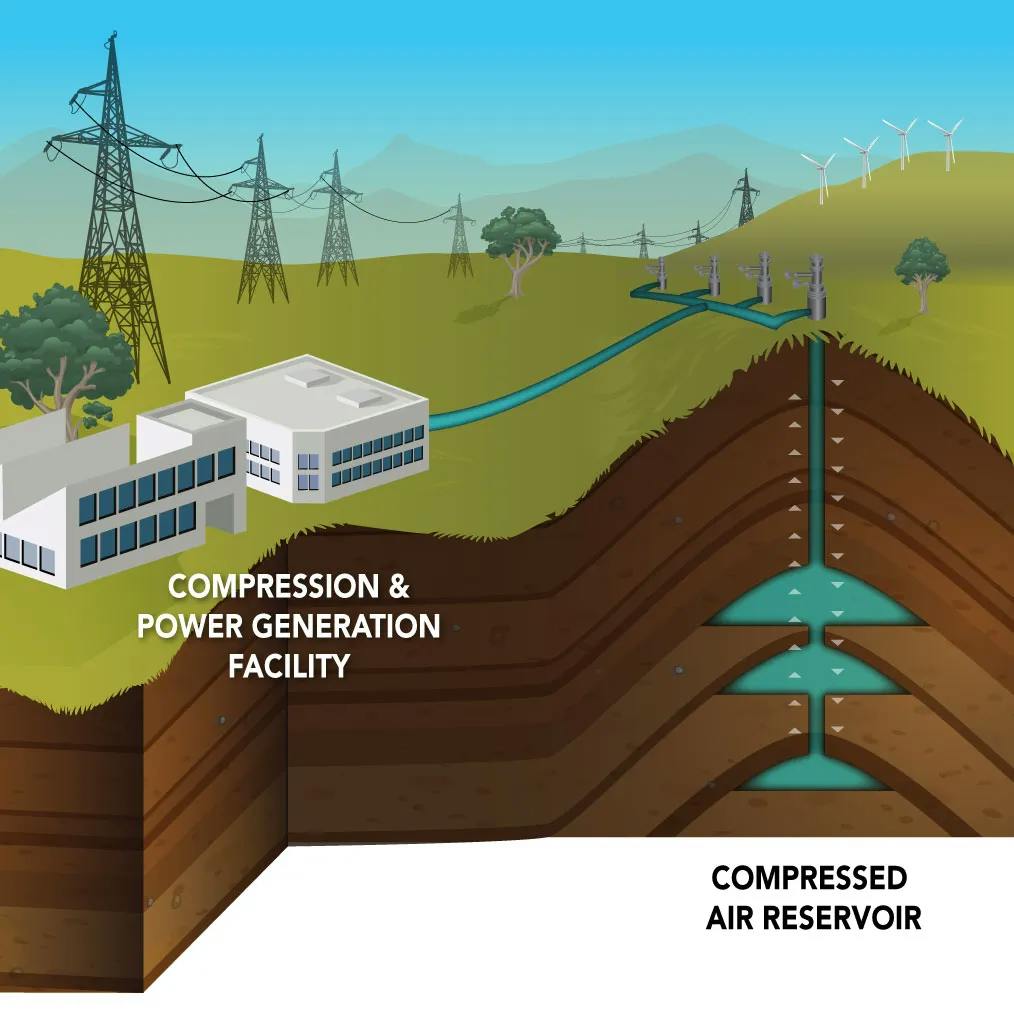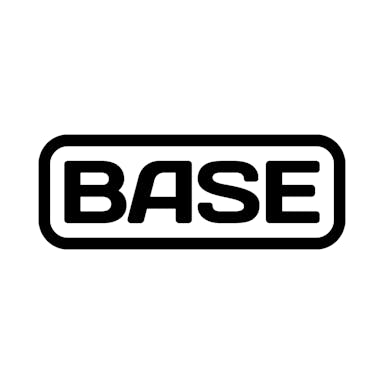Thesis
Industrial energy is the backbone of global manufacturing, responsible for roughly a quarter of all energy-related greenhouse gas emissions. Sectors like steel, cement, and chemicals require continuous high-temperature heat, which today is overwhelmingly supplied by burning fossil fuels (notably natural gas) due to their high flame temperatures and low cost. For example, natural gas has reportedly been about 5x cheaper per unit of heat than grid electricity, making it the default choice for around-the-clock operations. While renewable power from wind and solar is now cheaper than fossil electricity on a levelized basis, it is intermittent and thus insufficient alone for heavy industries that can’t afford downtime.
Energy storage is therefore the key to decarbonizing industrial heat: capturing excess renewable energy when it’s abundant and releasing it on demand. However, conventional batteries (like lithium-ion) are ill-suited: they excel at short-duration electricity supply (up to four hours) but are far too expensive (around $139 per kWh, if not more) to provide days of heat for thin-margin manufacturers. Thermal energy storage has emerged as a promising alternative to bridge this gap.
Antora Energy has developed a novel thermal “battery” that uses surplus renewable electricity to heat blocks of solid carbon to extreme temperatures (up to 2,400 °C) and store energy as high-grade heat. Whenever needed, this heat can be dispatched to run industrial processes or converted to electricity via specialized photodiodes. In other words, as one commentator put it, Antora builds batteries that are “hot as hell, and dirt cheap,” aiming to deliver zero-carbon heat at costs competitive with, or lower than, fossil fuels.
By enabling intermittent solar and wind power to provide 24/7 high-temperature heat, Antora’s technology could unlock the decarbonization of “hard-to-abate” industries that have so far had no viable alternative to fossil fuels. The thesis is that a low-cost, long-duration thermal storage solution will allow heavy manufacturers to transition to clean energy without sacrificing reliability or economics, mitigating a gigaton-scale source of emissions while tapping into a trillion-dollar energy market.
Founding Story
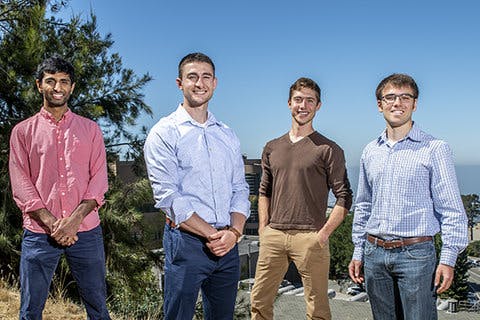
Source: Berkeley Lab
Antora Energy was founded in 2018 by Andrew Ponec (CEO) and Justin Briggs (COO), both Stanford graduates, together with David Bierman (Chief Commercial Officer), an MIT PhD in thermophotovoltaics.
The trio shared a mission to combat climate change and recognized that the industrial sector’s massive carbon footprint was relatively neglected by startups. They set out to develop an energy storage solution tailored to industry’s needs: delivering high heat output at low cost. Ponec had previously co-founded Dragonfly Systems as a Stanford undergrad, a solar electronics startup that was acquired in 2014 by the largest US solar retailer, SunPower. There, Ponec gained firsthand experience with the challenges of energy storage. As he explained:
"When people talk about long duration energy storage being a difficult problem, what they're really talking about is cost. They're saying, ‘Can you have something that can discharge for a hundred plus hours but that still has a cost per kilowatt, a cost per power capacity, that is competitive with other types of power capacity on the grid?’”
After leaving SunPower and returning to Stanford to complete his degree, Ponec met Briggs, who was researching scalable energy systems for industrial applications. The two began researching solutions for major climate problems and inevitably found the industrial sector. Accounting for nearly one-third of the planet’s emissions, this sector lacked the progress seen by transportation, grid management, and other adjacent markets. Lucky for both, the leading barrier to industrial decarbonization was energy storage.
From his time at Dragonfly Systems, Ponec knew that in power markets, price is the only factor that truly matters. As mentioned, lithium-ion batteries just couldn’t meet the need for cheap, stable, long-term storage. The pair considered a number of technical solutions, including hydrogen, compressed air, gravitational, flow batteries, etc., all of which failed due to high costs or low energy density (swamping any cost advantage due to installation/land cost). They settled on simplifying the overly complex designs of existing thermal storage systems.
Unbeknownst to them, David Bierman was a short drive away in Berkley, CA, working on a very similar product. A shared advisor, Brian Bartholomeusz, caught a presentation by Bierman’s and suggested they join forces. After considering forgoing the relationship and embracing competition, the trio decided to pool their knowledge in an attempt to make an industrial-scale thermal battery.
In 2019, they connected with another Stanford/MIT alum, Jordan Kearns, who had been working on software to switch industrial boilers to use cheap renewable electricity when available. Kearns’s startup (Medley Thermal) eventually merged into Antora in 2023, strengthening Antora’s project deployment capabilities. This “alumni reunion” gave Antora a unique combination of advanced thermal tech and practical integration know-how.
Product
Antora Energy’s thermal battery technology provides energy storage for industrial applications. But the fundamental innovation may be surprising. In a race to develop a high-density battery, Ponec notes that its unique value is actually a large gap in the center of the system:
“We took this solid block of carbon, separated two halves of it and created some void space in between those two walls of carbon. That void allows light to shine from end to end… instead of moving heat by pumping a liquid through all of the graphite, you could just open up this workspace and let the glow from this glowing hot carbon shine all the way to the edge of the system so that the heat is being transferred via light, rather than via moving molecules and moving atoms”
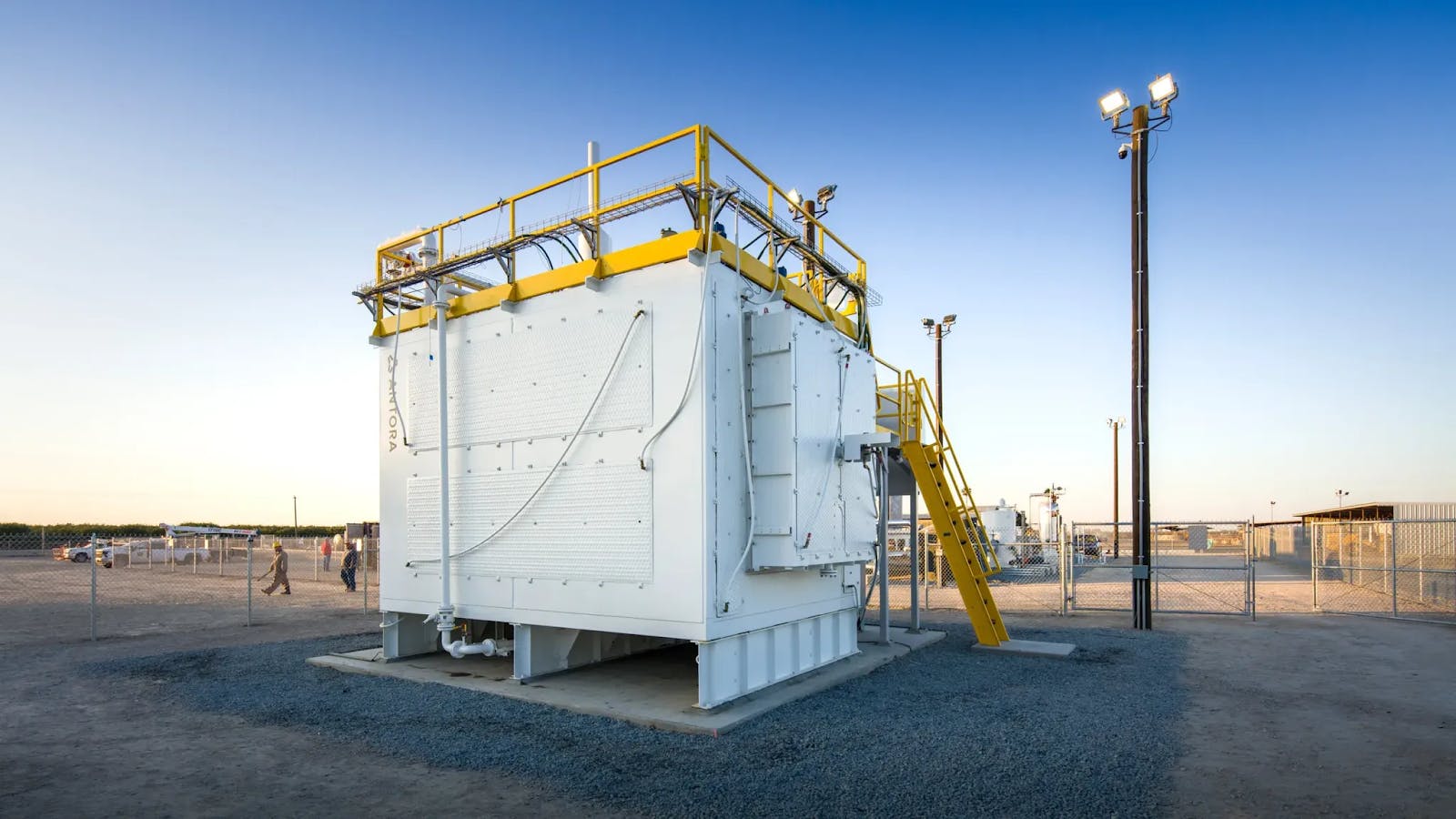
Source: MIT Technology Review
The system stores energy by heating blocks of solid carbon to 2,400°C, which can be discharged on demand as electricity or heat, removing the inefficiencies of using electricity to produce heat for industrial uses. There are three primary steps:

Source: Antora Energy
Charge: During times of cheap, renewable energy, Antora’s batteries undergo rapid charging and resistively heat large carbon blocks. This ultra-fast charging ensures the battery rarely, if ever, refills during expensive periods, which competing technologies struggle to avoid.
Store: White hot with energy, these carbon blocks store energy as heat for days. Carbon is uniquely suited for high-temperature energy storage due to its thermal conductivity, heat capacity, stability, and low cost. It’s also extremely cheap and abundant on Earth and has a much higher energy density than lithium-ion. To prevent heat loss, the system is wrapped in thermal insulation, allowing the stored heat to be retained for days with minimal losses of less than 1% per day.
Deliver: Unlike conventional thermal systems that rely on fluids, Antora’s design uses radiative heat transfer. The glowing carbon emits light, transmittable via small gaps between blocks, which is converted to electricity by Antora’s heat-to-power thermophotovoltaic (TPV) technology or transferred directly as heat. Why light and radiation instead of convection or conduction (how heat is usually transferred)? Because at these temperatures, the company claims that 99% of heat transfer occurs via light, a unique benefit attainable only via the carbon storage medium, which has a much higher heat capacity than other mediums. Antora’s TPV systems capture the thermal glow at over 40% heat-to-electricity conversion, a record when compared to solar photovoltaics, which capture about 20% of energy available from sunlight. What's more, unlike lithium-ion batteries, which undergo cycling degradation, carbon blocks do not experience cycle degradation. If that's not enough, since you can both heat a medium and extract the power from its bright light, the system can simultaneously charge and discharge.
Finally, one of the key benefits is modularity. Multiple thermal batteries can be linked together to serve a variety of load sizes. A typical medium-sized industrial space might need 100-200 batteries. Since the systems are relatively small (1/2 the size of a shipping container), they are shippable on a generic flatbed truck.

Source: Antora Energy
Carbon as a Storage Material
It’s important to note that Antora Energy’s decision to use carbon as its storage material was an uncommon yet fundamental one. Carbon is an attractive option because it is available at a very low cost, is abundant, and benefits from an extensive, established supply chain; all qualities that help ensure scalability at industrial levels. In fact, the metals industry produces roughly 30 million tons of carbon blocks each year, according to Antora, meaning even a modest share of that output can support terawatt-hours of energy storage. Moreover, carbon is conflict-free and non-toxic, avoiding many of the supply chain and environmental issues associated with other materials.
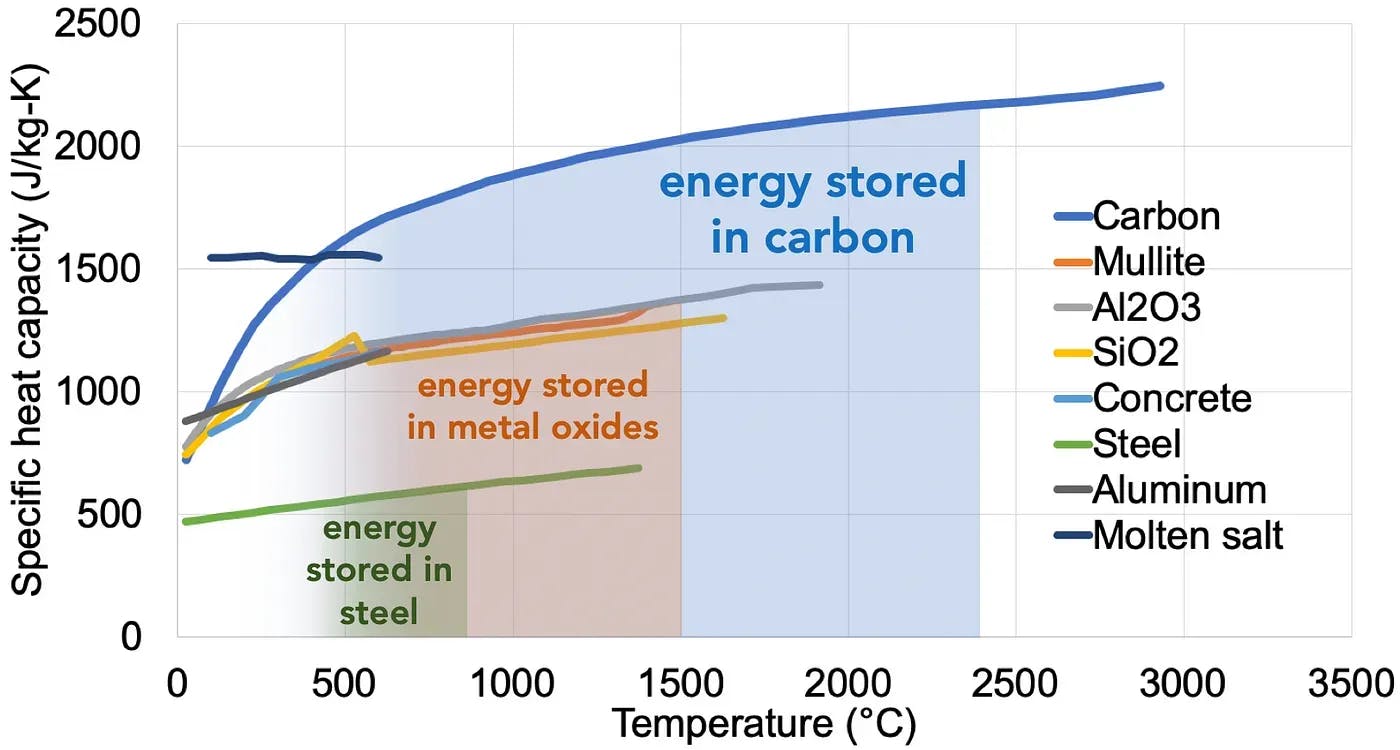
Source: Andrew Ponec
Beyond these supply and cost advantages, carbon also offers critical physical properties. It’s chemically stable at very high temperatures and “practically inert” in the operating environment, avoiding corrosion or degradation issues. Notably, carbon’s specific heat capacity increases at higher temperatures, meaning it can store more energy per kilogram when it’s white-hot than when it’s cool. This property, which the team initially overlooked, makes carbon even more effective for ultra-high-temperature storage. Unlike salts or metals, carbon blocks won’t melt or react at the temperatures Antora operates (remaining solid up to over 3000°C); and unlike lithium batteries, there are no scarce or toxic elements involved (graphite is essentially purified carbon, with no mining concerns beyond common mining impacts).
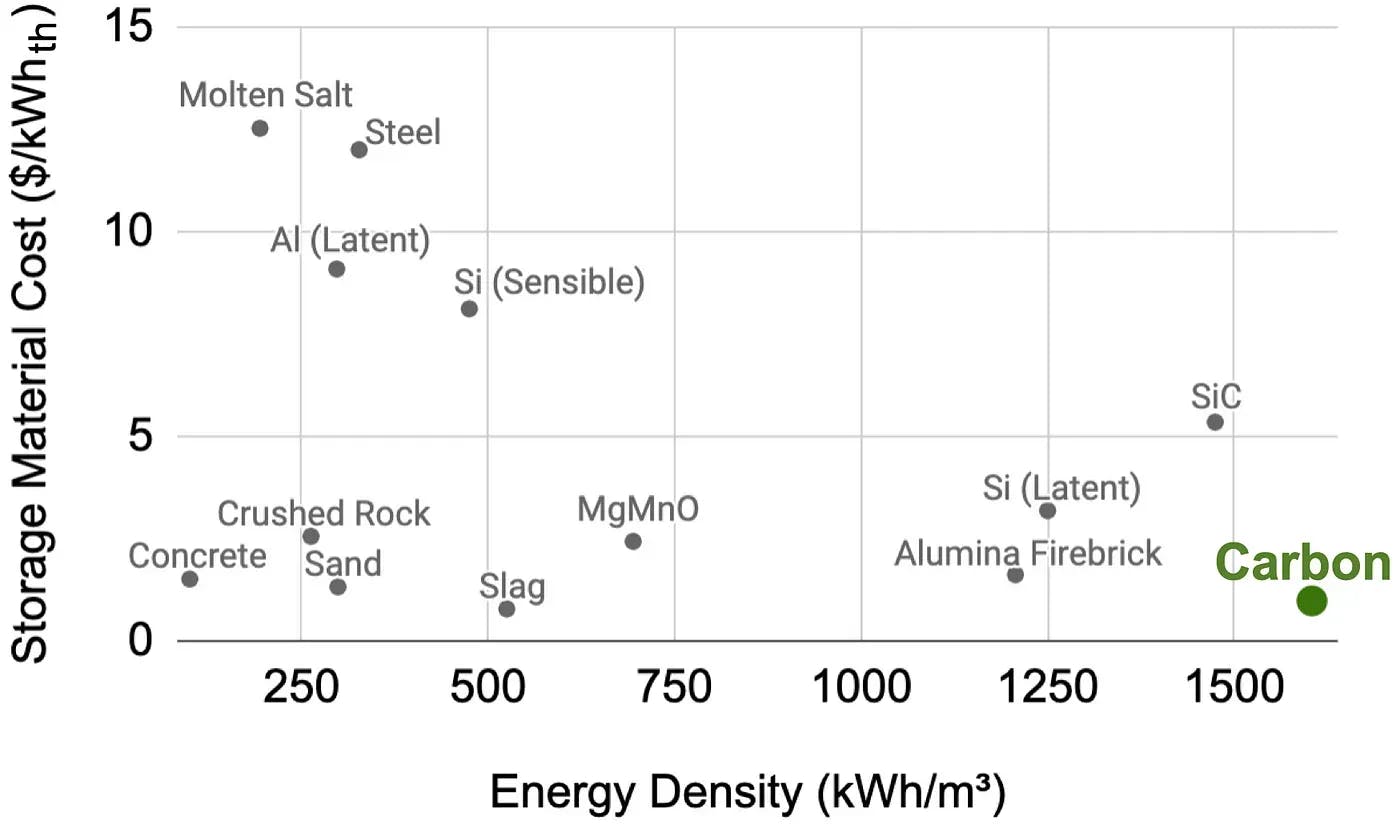
Source: Andrew Ponec
Market
Customer
Antora is targeting industrial sectors with significant process heat needs and a strong mandate to decarbonize. Traditional energy storage systems that convert electricity to heat are technically quite efficient but extremely cost-prohibitive, giving Antora a unique value proposition for industries with high heat demands. Key early customers include facilities that require heat up to ~400 °C, such as chemical manufacturing, food processing, paper milling, textiles, and biofuel production. These moderate-temperature processes represent a huge slice of industrial energy use (well over half of industrial heat demand is below 300 °C) and are often running 24/7 on natural gas or other fossil fuels. For these customers, energy costs, reliability, and emissions are critical pain points. Notably, as of 2024, about 70% of Fortune 500 companies have announced net-zero or emissions reduction goals, putting pressure on their operations to find clean energy solutions for heat.
Antora’s value proposition to these customers is a drop-in replacement for fossil-fired boilers/furnaces that provides equally reliable heat at a competitive price and with zero emissions on site. Initially, the company is focusing on use cases where its current technology can fully meet the needs (i.e., processes under ~400 °C). These include, for example, food and beverage factories (which use low-pressure steam for cooking and sterilization), pharmaceutical and chemical plants (which need consistent heat for reactions and distillation), and paper or textile mills (which use hot air for drying). By targeting these segments first, Antora can demonstrate success in a large portion of the market without immediately needing to push the envelope on temperature. Together, processes below 400 °C account for about 60% of all industrial heat usage and emissions.
Antora Energy is also positioning for the higher-temperature segments like steel and cement in the long run. Those sectors require >1000 °C heat and are among the world’s largest CO₂ emitters, but they are also the hardest to electrify. Antora’s current modules (~2,400 °C capability) actually exceed the temperature needs of steel and cement processes, but integrating into those industries may require additional engineering (for example, different heat delivery mechanisms or larger-scale modules). The company has hinted at a future “HeatMax” product line for ultra-high-temperature, which could directly compete with alternatives like green hydrogen combustion for steel/cement.
Market Size
The market for industrial energy storage and clean heat solutions is enormous and growing rapidly. Antora’s technology sits at the intersection of the global green energy transition, valued at ~$1 trillion in 2022, across renewables and enabling tech and the industrial heat market which itself represents about 20–30% of worldwide energy consumption each year. The broad green energy market is projected to reach $2.4 trillion by 2032 as nations invest in renewable generation and related infrastructure. Within that, the opportunity specific to industrial clean heat is often cited as “a brand new trillion-dollar market” opening up for renewable developers and technology providers. In CEO Andrew Ponec’s words:
“Our investors look at this and see a $1 T/year opportunity. We look at it and see a 10 gigaton/year opportunity,”
Drilling down to Antora’s immediate addressable market, Ponec noted that around $100 billion is spent annually on industrial process heat in the US alone. This implies a substantial market just in providing cheaper heat to domestic industry that is also clean. Globally, the industrial heat sector consumes on the order of $1 trillion worth of energy per year, predominantly on fossil fuels. Importantly, the demand for long-duration energy storage (LDES) in industry is expected to grow faster than the general storage market as more factories seek 24/7 clean power. Industry analysts project that investments in industrial storage solutions will outpace those in traditional grid batteries because heavy industry requires very high capacity and reliability, a niche that lithium-ion and short-duration systems cannot fill.
For instance, a single large cement plant can consume 250 MW of thermal power continuously, equivalent to the electricity use of 250K households. Decarbonizing just one such plant could translate to hundreds of megawatt-hours of storage deployment, but cost remains the prohibitive factor. The cost of producing one ton of cement or steel increases by 50-100% or more when comparing coal to common renewables. However, Antora believes that by absorbing energy during cheap periods and efficiently storing it, this will no longer be true.
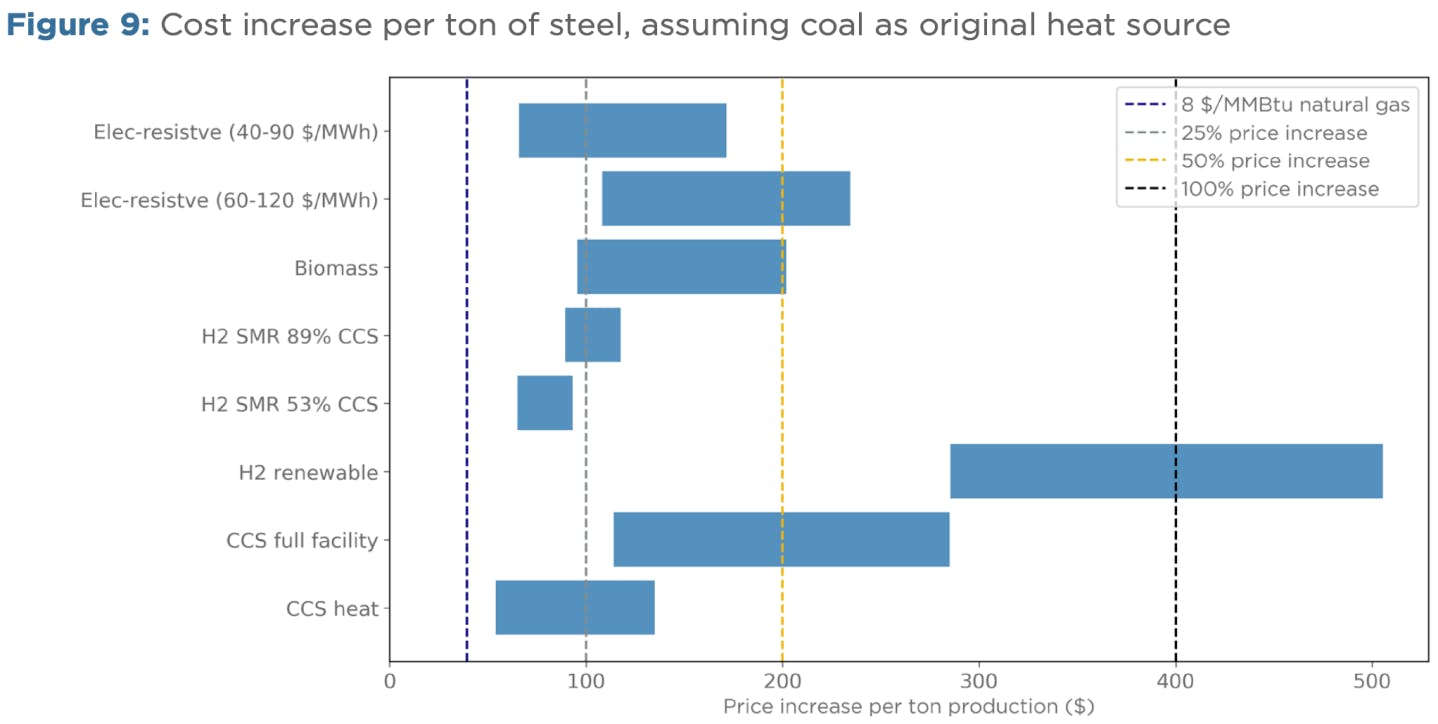
Source: Center on Global Energy Policy
In addition to pure market forces, policy and corporate trends are expanding the market. Government mandates, including carbon pricing, clean energy standards, and fossil fuel phase-outs, are increasingly targeting industrial emissions. The US Inflation Reduction Act (IRA), EU Green Deal, and similar initiatives are collectively funneling hundreds of billions of dollars into clean energy and industrial decarbonization projects. The IRA alone allocated $369 billion to clean energy projects. This significantly lowers the economic barrier for industrial players to invest in solutions like Antora’s via tax credits, grants, and co-funded demo programs. The company’s ability to capture a share of that market will depend on execution, but if it can deliver on its cost promises, the demand is essentially as large as the industrial sector’s energy demand itself. Even a niche like high-temperature processing of commodities (metals, cement, chemicals) represents billions in potential revenue
Competition
Alternative Energy Storage Technologies
Antora Energy competes against a range of existing and emerging solutions for providing reliable energy to industry. The incumbent baseline is fossil fuel, which sets a high bar for cost and convenience. Among non-fossil options, various energy storage technologies have been considered for buffering renewable energy.
Lithium-Ion Batteries (Li-ion): The workhorse of grid and EV storage, Li-ion batteries offer high electrical efficiency and fast response. However, they are optimized for short-duration electricity storage (on the order of hours) and are prohibitively expensive for delivering days of heat. At an average pack cost of ~$100–140 / kWh, Li-ion systems would multiply energy costs for manufacturers, which is untenable in commodity industries. Li-ion batteries also output electricity, not heat, so using them for industrial heat requires an electric heater, an extra step that adds loss and cost. In short, they excel for peak shaving and EVs, but for 24/7 process heat, their cost per delivered BTU is far above fossil fuels, and they do not scale well to multi-megawatt for multi-hour needs.
Green Hydrogen: Hydrogen can serve as a fuel for high-temperature processes and is seen as a long-term energy storage medium. Importantly, hydrogen can directly replace natural gas in burners, providing both heat and a zero-carbon exhaust (water vapor). The challenge is that green hydrogen (H₂ from electrolysis) is still extremely costly at over $5 per kilogram in 2024, which equates to about $37 per MMBtu of heat, nearly 10× the price of natural gas for industrial users. Moreover, storing and transporting hydrogen at scale requires new infrastructure (pressurized tanks, pipelines, or liquefaction) and entails efficiency losses. Hydrogen makes sense in certain niche applications, and it’s a promising fuel for steel or ammonia, where the H₂ can be chemically utilized, but as a general heat solution, it remains uneconomical and logistically complex today. Until hydrogen costs drop dramatically and infrastructure is built out, it is more of a future option for broad industrial heat usage.
Compressed Air Energy Storage (CAES): This is a long-duration storage method that pumps air into underground caverns under pressure and later releases it to drive a turbine for electricity. CAES has been used at utility scale in places such as Alabama and Germany, and can be very cost-effective per kWh stored. However, CAES requires specific geologies, salt domes or aquifers, to store the air, and it outputs electricity rather than heat. An industrial site would still need a way to convert that electricity to process heat. The geographic limitation and the high upfront capital for caverns and compressors mean CAES isn’t a broadly applicable solution for diverse factories.
Thermal Storage with Molten Salt: Molten nitrate salts are used in some concentrated solar power (CSP) plants to store heat at ~565 °C, which is then used to generate steam for electricity. Molten salt storage is proven and efficient in a narrow temperature range (200–500 °C). This makes it viable for low-to-medium-temperature needs, but insufficient for industries like metals or glass that require >1,000 °C. Also, molten salt systems are large, heavy, and must be kept hot 24/7 to avoid the salt solidifying. This adds complexity if used outside of dedicated facilities. In tightly controlled environments like solar farms, they work well, but in typical factories, implementing molten salt would be complex and costly.
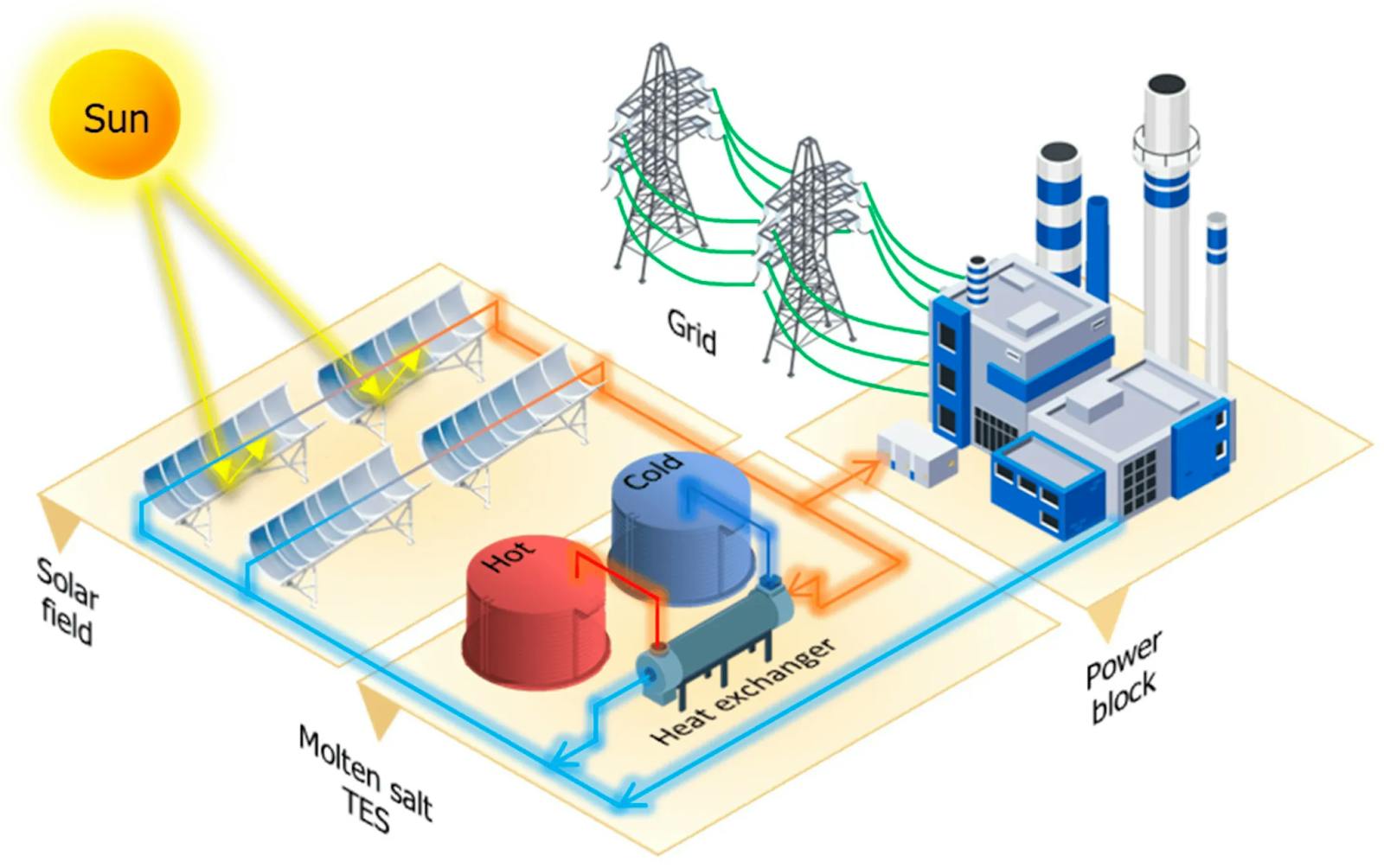
Source: MDPI
Other Concepts: Other long-duration storage ideas include flow batteries, pumped heat / electrothermal storage, gravity storage (e.g., lifting weights or water), etc. Each has specific use-cases, but generally they struggle with either cost, efficiency, or power density when scaled to the needs of heavy industry. For example, a flow battery can store energy for many hours, but it would be enormous and costly to supply the continuous 100+ MW thermal needs of a cement plant. Gravitational storage is unsuitable for on-site industrial use and is mostly proposed for grid storage near mountains or mineshafts. Direct electrification via heat pumps or resistance heaters can work for low temperatures (and indeed many <150 °C processes could use commercial electric boilers), but at higher temperatures, electric heaters face material limits and are very expensive to run continuously off-grid power.
According to Ponce, who ran the math on all of these alternatives before founding Antora Energy, thermal storage simply wins on cost, simplicity, and “nearly infinite scalability.”
Direct Competitors
Within the thermal energy storage space, there are several companies leveraging different elements and processes to achieve the same goal.
Rondo Energy: Founded in 2020, Rondo Energy employs brick-based heat batteries to store renewable energy as high-temperature heat, targeting industrial sectors with significant decarbonization needs. These batteries use electric heating elements to heat arrays of firebrick, refractory ceramic bricks. The hot bricks then discharge via convection: air is blown through the brick stack to produce hot air or steam for industrial use.
Rondo’s brick batteries can reach about 1,500 °C in the core, but by the time the heat is transferred to a working fluid, the delivered temperature is closer to ~1,000 °C. This is sufficient for many applications, but it’s lower than Antora’s 2,400 °C capability. With only four hours of charging, these batteries can provide heat day and night. In the long term, the higher temperature capacity of Antora’s system may make it more suitable for processes requiring extreme heat, such as certain metallurgical applications, but plenty of opportunity lies in the sub-1,000 °C market.
In terms of traction, Rondo is slightly ahead in deployments. It built a pilot unit in California and, as of 202,3 had its first commercial system operating at an ethanol plant providing process steam. Rondo has attracted a mutual investor, Breakthrough Energy Ventures, who appreciate its diverse customer base, which includes chemical manufacturers, industrial parks, and food production. In its first four years, the company raised $162 million, never disclosing its valuation. Overall, the company has raised $190 million in equity across multiple rounds, including $60 million in late 2022 at a $347 million valuation, and $79 million in debt financing to fuel manufacturing growth.

Source: Rondo Energy
Electrified Thermal Solutions (ETS): A startup spun out of MIT in 2021, ETS makes the “Joule Hive” thermal battery. This system uses conductive firebrick as the storage medium, similar to Rondo’s bricks, but the bricks are doped to be electrically conductive. By running current directly through the bricks (Joule heating), ETS heats them to ~1,800 °C, then discharges heat via fluid flow for industrial processes, turning the bricks themselves into heating elements.
Bricks generally have lower thermal conductivity than carbon. Typical firebrick has thermal conductivity around 0.15 to 1.31 W/mK, whereas carbon-based blocks can be ~1.7 W/mK or higher. This means Antora’s carbon blocks can transfer heat out faster and more efficiently than ETS’s bricks, potentially leading to quicker response or smaller heat exchangers. ETS is targeting industries like metals forging, ceramics, and glass, all of which traditionally use natural gas or oil for heat.
ETS is an earlier-stage company; it had raised just under $24 million as of August 2025 and was also a recipient of a $35 million DOE grant in 2024 to demonstrate its “Joule Hive” at a Tennessee Valley Authority-connected chemical plant. The ETS system’s strength is simplicity and robustness, as bricks are cheap and familiar, and by embedding heating into them, system complexity is reduced. However, like Rondo, it does not produce electricity. It’s focused purely on heat delivery.
Fourth Power: Founded in 2021 by MIT professor Asegun Henry, Fourth Power is tackling a similar thermal storage problem but aiming for the power generation of the electric grid rather than directly at industrial heat. Fourth Power’s design also uses graphite blocks heated to ~2,000+ °C, but it employs molten tin as an intermediate heat transfer fluid and a TPV system to convert heat to electricity. In other words, Fourth Power is very much like Antora in technical concept, graphite + TPV, but is not delivering heat to industrial customers; it’s making a long-duration electricity battery for utilities.
Fourth Power’s use of molten metal is unique: the system heats liquid tin with resistance heaters, pumps the hot tin through a graphite core to charge it, and during discharge, the tin is circulated to draw heat out of the graphite, emitting intense thermal radiation onto TPV cells. They have achieved similar high temperatures and conversion efficiencies as Antora (over 40% TPV efficiency at 2,400 °C).
Fourth Power raised a $19 million Series A in late 2023 and benefits from Asegun Henry’s pioneering TPV research. Fourth Power’s first pilot is a ~10 MWh demo near Boston. While not a direct competitor for industrial customers, Fourth Power does compete in terms of technology and talent.
While several other companies operate in the broader energy storage space, they are less direct competitors to Antora. EnergyNest’s modular thermal batteries, made from the proprietary Heatcrete material, focus on moderate-temperature heat storage (250-500°C), making them ideal for industries like food processing and district heating but unsuitable for high-temperature applications. Malta Inc. and Highview Power primarily address grid-scale electricity storage rather than industrial heat. Malta uses molten salt and chilled liquid for electricity-to-heat-to-electricity storage, while Highview employs liquid air for long-duration storage. These technologies are excellent for managing renewable intermittency in power grids but lack the temperature capabilities and industrial focus of Antora’s solution. Energy Dome’s CO2-based battery system is another grid-scale solution, but it is not designed for thermal applications or industrial heat.
Business Model
For industrial clients, the decision to adopt Antora’s technology boils down to a simple calculation: Will the delivered cost of heat (or power) from the thermal battery be cheaper or at least on par with burning fossil fuel? Antora’s business model is built to make the answer “yes” by leveraging low-cost renewable energy and providing flexible financing. The company offers its solution under a “Heat-as-a-Service” model. Instead of selling a giant battery device for an upfront price, Antora can install its thermal batteries at a customer’s site and then sell the output (heat or electricity) to the customer under a long-term contract. This allows industrial users to pay for clean heat as they use it, without having to shoulder the capital investment or new operational complexity. It’s a similar concept to power purchase agreements (PPAs) in solar; the client gets a guaranteed energy price, often lower than their current fossil fuel bill, and Antora owns and operates the equipment. This model helps overcome the procurement conservatism of manufacturers by simplifying the decision to a cost-saving service agreement rather than a risky equipment purchase. In cases where a customer prefers to buy the asset, Antora also sells the systems themselves.
Over time, as the technology scales, Antora’s goal is to drive the levelized cost of thermal energy below what industrial consumers pay for natural gas, on an energy-equivalent basis. This involves two factors: securing super-cheap electricity to charge the batteries, and manufacturing the batteries at low enough capital cost. On the first factor, Antora plans to use the lowest-cost electricity on the market, typically excess solar or wind power during off-peak times. In regions like California or Texas, solar generation at midday is now so abundant that power prices drop near zero or even negative. By charging its batteries in those periods, Antora ensures the input energy is extremely cheap. The stored heat can then be supplied when energy is expensive (e.g., at night). This arbitrage allows Antora to profit while still offering the customer a discount versus burning fuel. Essentially, Antora is monetizing the spread between cheap renewable electricity and costly on-demand fossil heat.
On the second factor, Antora’s ability to hit cost targets depends on manufacturing scale and efficiency. The company’s strategy is to mass-produce a standardized module, rather than custom-building units for each project. By keeping the design modular and consistent, it can leverage factory learning curves. Antora has a dedicated facility for producing its TPV cells and likely assembles modules using contract manufacturers for steel casings, carbon blocks, etc. As volume grows, unit costs should fall. The modular design also shortens deployment time for customers: units can be delivered on a truck and installed with minimal downtime, plugging into existing infrastructure. This is a selling point in the business model – customers don’t have to overhaul their whole factory; Antora’s unit can integrate with their current boilers or heaters to supply clean heat in parallel, ensuring no disruption to operations while they transition.
Traction
As of August 2025, Antora Energy had successfully deployed pilot projects across various sectors. In 2023, it commissioned its first commercial-scale thermal battery in partnership with Wellhead Electric. The 5 MWh unit, installed near Fresno, California, was powered by local solar and, according to Antora, marked the world’s first thermal battery to deliver continuous 24/7 industrial heat and power from renewables in a real operating setting, at least with a carbon block and TPV model.
That same year, Antora opened a 50k sq ft manufacturing facility in San Jose to house its thermophotovoltaic (TPV) cell production line and battery unit assembly. As of 2024, this facility represented the world’s largest TPV manufacturing operation. In-house production has allowed rapid iteration, enabling Antora to reach over 40% heat-to-electric conversion efficiency, which is key in making combined heat-power systems commercially viable.
On the customer side, Antora has gained traction with heavy industrials, including a major role in a DOE-backed cement decarbonization project. In March 2024, the DOE announced a consortium led by Summit Materials would build four low-carbon cement plants in the US, integrating Antora’s batteries to help provide kiln heat, aiming to cut ~1.1 million tons of CO₂ emissions annually, according to the company. Also found participating in this group are competitors Rondo Energy, ETS, and more.
Valuation
In February 2024, Antora raised a $150 million Series B led by Decarbonization Partners (BlackRock and Temasek), having raised a total of $230 million by August 2025. An additional $14.5 million awarded by ARPA AE later that year brought total funding to $244.5 million as of August 2025. Additional investors include a number of well-known climate investors, including Trust Ventures, Lowercarbon Capital, Breakthrough Energy Ventures, BHP Ventures, Emerson Collective, Overture VC, Grok Ventures, and many more. Funding across the long-duration energy storage (LDES) market has increased 36x between 2018 and 2023.
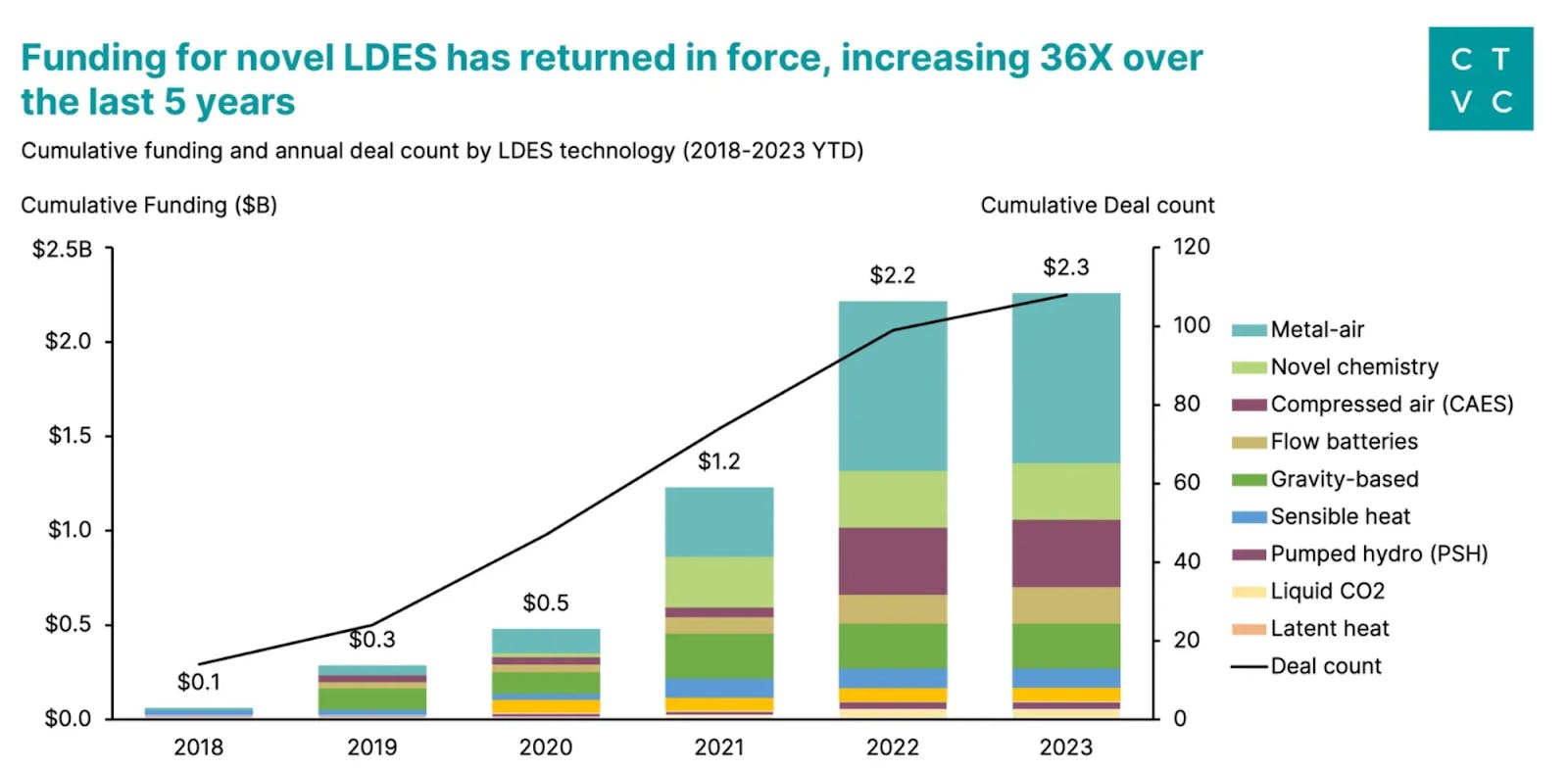
Source: CTVC
Though Antora Energy’s revenue is unknown, and most likely small, as the company is just engaged in pilots, it’s helpful to view public comparisons. Fluence Energy, a publicly-traded leader in grid-scale energy storage, is valued at approximately $1.4 billion as of August 2025. Similarly, Bloom Energy, specializing in fuel cell technologies for industrial applications, has a valuation of $11.6 billion.
Antora’s valuation is estimated to be around $500 million as of 2024, relatively high for a company with limited revenue. High expectations and future valuation growth will depend highly on scaling manufacturing, something Elon Musk claims is “somewhere between 100-1000x harder than making a prototype.” Securing additional commercial contracts and reducing costs through economies of scale will also play a major role in the company’s next five years.
Key Opportunities
Expanding Market for Industrial Energy
The industrial heat sector represents 20% of global energy consumption and contributes heavily to global carbon emissions. Powering this sector has become a $1 trillion market opportunity as of 2023. Antora’s cost-effective and modular thermal battery system directly addresses the needs of industries like steel, cement, and chemicals, positioning it as a frontrunner in this massive and under-penetrated market. As costs of renewables continue to decrease, every major industry is moving from fossil fuels to clean energy, and industrial heat seems to be following suit. As Ponec says:
“Our investors look at this and see a $1T/year opportunity. We look at it and see a 10 gigaton/year opportunity.”
Favorable Policy Landscape
Public policy is increasingly a driving force behind industrial decarbonization, and Antora is positioned to benefit from this policy tailwind. In the United States, the Inflation Reduction Act of 2022 earmarked $369 billion for clean energy and climate initiatives, including tax credits for energy storage and grants for emissions reductions in industry. The IRA’s storage Investment Tax Credit (ITC) alone can cover 30% of the capital cost of storage projects. Crucially, the DOE has launched programs like the Industrial Demonstrations Program and Advanced Industrial Facilities Deployment Program, which specifically fund the first-of-a-kind installations of technologies to cut industrial emissions.
Antora has already capitalized on this: it won a competitive DOE award for the cement project, effectively getting government support to de-risk a major deployment. These programs essentially subsidize early adopters, addressing the “valley of death” for new tech in heavy industry by sharing costs and risk. This helps overcome the conservative procurement processes of manufacturers (who are risk-averse by nature). If DOE is backing a project, it gives credibility and financial cover to try Antora’s solution.
Internationally, policies like the EU’s Green Deal and Carbon Border Adjustment are pressuring industrial emitters to adopt clean technologies or face penalties. Europe is funneling billions into industrial innovation funds and offering contracts-for-difference for low-carbon production. Antora’s technology aligns well with these policy incentives, as it directly reduces emissions and can qualify for support. Additionally, many jurisdictions are introducing or increasing carbon prices, which will make fossil fuel heat more expensive over time and improve the relative economics of thermal storage.
Another angle is the resilience and reshoring agenda. The US government is interested in technologies that can bolster domestic manufacturing while cutting emissions and dependencies on foreign countries’ imports. Antora’s batteries, being manufactured in the US, play into the goals of US clean tech leadership and energy security.
Grants reduce upfront costs, tax credits improve ROI, carbon pricing increases the cost of sticking with fossil fuels, and government-led demos help ease customer fears. This policy-driven momentum is effectively a tailwind that can accelerate Antora’s market penetration.
Superior Cost Positioning
Antora’s technology uses low-cost inputs: inexpensive carbon blocks, off-the-shelf insulation, and standard steel containers. There are no exotic or high-cost materials that would keep costs high. Moreover, the system is highly efficient in its domain. Nearly all the energy put in as electricity can be recovered as useful heat or power (aside from extremely minor heat losses). Antora engineers the battery to charge when electricity is extremely cheap (say <$0.02/kWh, during solar noon or windy nights). The stored heat is then used in lieu of burning natural gas, effectively arbitraging the difference in price. Industrial gas prices vary, but even at $5–10 per MMBtu, Antora can beat that if the electricity input is low-cost and the storage has enough cycles.
Additionally, because the battery can provide both heat and electricity, a customer could offset not just fuel costs but also some electricity purchases via the TPV output. This dual use enhances the economic value of each unit. Antora’s approach avoids the inefficiency of double conversion (electricity to heat to electricity in separate steps) by integrating TPV; it effectively can achieve efficiencies that make the delivered energy competitive. In fact, Antora often says no “green premium” is required, meaning the customer doesn’t have to pay more for clean heat; it’s at least cost-neutral or better.
Meanwhile, fossil fuel costs in many parts of the world are increasingly volatile due to carbon taxes or supply and trade issues. For instance, Europe’s natural gas spiked massively in recent years; if such volatility continues, a stable-cost solution like Antora’s (tied to fixed PPA prices for renewables) is very attractive. Even in the US, gas prices for industry can be volatile, and adding a likely future carbon price would effectively raise them. Antora provides a hedge against fuel price volatility by offering long-term fixed pricing, which CFOs appreciate.
Scalability of Modular Design
Each Antora battery unit is a repeatable product, akin to a large appliance, that can be manufactured in series. This manufacturability means Antora can scale production volume much like a solar panel or a car, driving down per-unit costs and deploying units quickly to wherever they’re needed. Unlike bespoke engineering solutions that require custom on-site construction (for example, building a bespoke molten salt tower or a new hydrogen boiler at each facility), Antora’s units are standardized and shippable. This modular approach not only reduces cost but also significantly speeds up deployment timelines. A customer could start with a small installation and add modules incrementally as their needs grow or as they gain trust in the technology. This flexibility lowers the barrier to adoption; companies don’t have to gamble on an enormous one-time conversion of their whole plant, they can phase it in module by module.
From Antora’s perspective, modularity allows it to tap into industrial supply chains and contract manufacturers. The company can outsource the fabrication of subcomponents (the steel skids, heating elements, etc.) to experienced manufacturers, and then focus on assembly and integration. This is a much more scalable proposition than trying to build each system one-off on a customer’s site. It also means Antora can scale geographically without needing to do complex site engineering each time, similar to how Tesla Model 3s are built globally.
The modular design also ensures minimal disruption to existing facilities during installation. As noted, an Antora module is delivered on a truck and can be installed in parallel with current systems. This means an industrial plant can test one module while the rest of its operation runs normally, then scale up usage.
Finally, modularity means risk is compartmentalized. If one module has an issue, it can be swapped out or serviced without taking down an entire plant’s heat supply. This is important for industries that require high uptime. It also means capacity can be added or reallocated. If a factory shuts down, modules could potentially be moved to another site. Traditional large boilers are sunk capital in one location; a fleet of modular batteries is more flexible as an asset.
Key Risks
Slow Customer Adoption Cycles
Industrial customers are famously conservative and slow-moving when it comes to adopting unproven technology, presenting a fundamental risk to Antora’s growth. Large manufacturers typically have long procurement and decision cycles, often stretching many months to years for major energy infrastructure changes. They worry about production downtime, safety, and return on investment, and they tend to stick with known, reliable solutions. Introducing a new kind of energy storage into critical processes can be viewed as high risk.
Even though thermal batteries are inherently simpler than lithium-ion systems, they are new and have not gained full industry trust. Lithium-ion is still an industry standard. The US DOE has even published the National Blueprint for Lithium Batteries 2021-2030, which outlines plans for developing a domestic lithium-battery manufacturing value chain.
Even if Antora’s technology is technically sound, persuading plant managers and corporate boards to retrofit or replace existing boilers will take time. Many industrial firms operate on thin margins (especially in commodities like steel or cement), and they cannot afford any disruption or underperformance in their energy supply. This means that sales cycles for Antora could be lengthy, and even once a sale is made, the customer might insist on a small pilot, then a phased scale-up over years. Industrial firms often use a stage gate approach; they will trial one unit, then require internal analysis and approval before ordering more. If anything in the pilot underperforms, it could halt further adoption.
Another factor is that many heavy industries have long asset lifetimes; furnaces, kilns, and boilers can run for decades. Companies might time adoption of Antora’s solution to coincide with the natural turnover of equipment. If, for instance, a plant’s boiler was just replaced in 2018 with a 30-year unit, they may not seriously consider an Antora system until that asset nears end-of-life in the 2040s. This creates a potential lag in addressable market, unless regulatory pressure forces earlier changes.
There’s certainly a chicken-and-egg problem here. The more companies begin using Antora Energy’s product, or other thermal battery solutions, the more others will feel the decision has been de-risked. An inflection point must be met for exponential growth to begin.
Manufacturing Scale-Up Challenges
Scaling up manufacturing poses one of Antora’s biggest execution risks. The company currently operates the world’s largest TPV fab at just 2 MW/year capacity; enough for only a few modules annually. Expanding this production line to tens of MW/year or more will demand significant capital investments, advanced semiconductor equipment, and solving yield and reliability issues. Any shortcomings here could lead to production bottlenecks or increased costs.
Finally, Antora faces complexity in developing efficient assembly lines and scaling field deployments. Designing the manufacturing process itself, including integrating heaters, TPV panels, and controllers, can introduce costly delays and operational inefficiencies. Moreover, coordinating logistics for shipping, site preparation, and installation across multiple concurrent customer deployments will likely strain company resources. Achieving rigorous quality control to prevent potentially catastrophic field failures such as thermal runaway events is essential, but balancing thorough testing with high throughput remains challenging.
Supply chain risks also loom. Although Antora’s carbon blocks use relatively common materials, securing consistent, high-quality graphite at scale could present logistical challenges and potential competition with other industries. Additionally, specialty insulation materials and refractory components must be reliably sourced in volume. Delays or quality inconsistencies in these areas could slow assembly, while rigorous quality assurance to maintain vacuum seals and inert environments may further complicate and lengthen manufacturing processes.
Summary
Antora Energy stands at the forefront of the industrial decarbonization movement, providing an innovative solution to one of the most challenging aspects of global emissions: industrial heat. With its cost-effective, modular thermal storage system, Antora is focused on offering a compelling, reliable energy solution and an attractive proposition for industries grappling with regulatory pressures and sustainability goals.
However, Antora faces challenges, including scaling production, securing customer adoption in traditionally cautious industries, and competing with well-funded rivals such as Rondo Energy and Electrified Thermal Solutions. Additionally, the company must maintain its cost leadership. If Antora can successfully scale its operations and convert its growing pipeline into long-term customers, it has the potential to redefine industrial energy storage and play a transformative role in the global transition to a zero-carbon economy.

